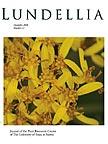A new name, Abutilon ulbrichii, is proposed to replace the later homonym Abutilon longipes Ulbr. for a South American species (non A. longipes Mattei from Africa).
In 1916 Ulbrich published the name Abutilon longipes Ulbr. for a Peruvian species, unaware of the fact that Mattei had published the same name seven years earlier for a plant fromEritrea in Africa. Ulbrich's name, thus, is a later homonym (Fryxell, 2002) and illegitimate according to Article 53.1 (McNeill et al., 2006). Therefore, if the South American plant is to be recognized, as was done by Kearney (1958) for example, a new name is required. Recent studies indicate that Ulbrich's plant is to be distinguished from other South American species of Abutilon, giving immediacy to the nomenclatural problem. Therefore, the following new name is proposed.
Abutilon ulbrichii Fryxell, nom. nov. Replaced name: Abutilon longipes Ulbr., Bot. Jahrb. Syst. 54 (Beibl. 117): 52. 1916, non Abutilon longipes Mattei, Boll. Reale Orto Bot. Palermo 8: 85. 1909.
The type of the new name (Fig. 1) is that of the replaced name, viz., PERU. Ayacucho: Prov. De La Mar, between Tambo and the Apurimac, below Janamonte, 2400–2500 m, Jun 1910, A. Weberbauer 5599 (Holotype: B?; Isotypes: F as photo F-64859, GH, MOL?, US, USM?).
It has its closest ally in Abutilon peruvianum (Lam.) Kearney (basionym: Sida peruviana Lam.). The two species are distinguished from other species of Abutilon by a distinctive calyx, which is large and deeply parted and has relatively narrow lobes. Kearney (1958) distinguishes these two species as follows:
Peduncles shorter than the subtending leaves; blades crenate. Ecuador (?), Peru, Bolivia.
A. peruvianum (Lam.) Kearney
Peduncles longer than the subtending leaves, up to 16 cm long; blades denticulate. Peru.
A. longipes Ulbr.
Unfortunately, Lamarck's original description does not mention the calyx, so that there is little direct basis for allying Lamarck's species with that of Ulbrich. Lamarck states that the plant was grown in the Royal Botanic Garden in Paris and that he described it from the living plant (v.v.). A specimen is preserved in the Lamarck herbarium, as noted by Fryxell (2002), that is evidently the type of Abutilon peruvianum (Lam.) Kearney. The specimen bears only the notation “Sida peruviana. j.” in what is evidently Cavanilles' handwriting. The “j” may signify “jardin,” indicating that the plant was cultivated, but that is speculation.
However, the history of the basionym Sida peruviana Lam. is a bit fuller. As stated, Lamarck based the name on a plant grown in the Royal Botanic Garden in Paris. This same plant was observed by Cavanilles, who also published the name Sida peruviana (Diss. 1: 36. t. 7, f. 8. 1785), attributing the name to Jussieu and citing “Abutilon du Perou, E ` ncyc. no. 19,” which is a direct reference to the name and description published by Lamarck. The drawing mentioned by Cavanilles (t.7, f.8) is rather crudely executed and provides insufficient information to be certain of the plant depicted. At a later date, however, Cavanilles published a supplementary account of this same plant (Diss. 5: 276. t. 130. 1788), with a much fuller description and a more critically executed illustration (reproduced here as Fig. 2). The latter illustration and the specimen in the Lamarck herbarium are in rather close agreement (although not identical), suggesting that the same plant was consulted in preparing the drawing.
Abutilon peruvianum has not been found to occur in Ecuador (Fryxell, 1992), confirming Kearney's doubt expressed in the key (above), and A. longipes Ulbr. (5 A. ulbrichii) may occur in Bolivia in addition to Peru, but further study is required to clarify the distributions of these two species.







